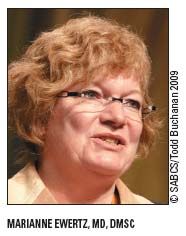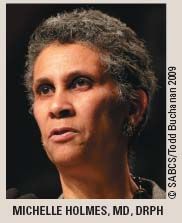Obese breast ca patients carry greater recurrence risk
A 30-year study of nearly 20,000 Danish women made a defensible connection between obesity and poor prognosis after breast cancer diagnosis and treatment.
SAN ANTONIO-A 30-year study of nearly 20,000 Danish women made a defensible connection between obesity and poor prognosis after breast cancer diagnosis and treatment. Moreover, obese women don't respond as well as nonobese women to breast cancer treatment, according to the study presented at SABCS 2009.
Marianne Ewertz, MD, DMSc, and colleagues with the Danish Breast Cancer Cooperative Group used a national database to identify 53,816 women who had received treatment for early breast cancer between 1977 and 2006. The patients also had to have complete follow-up data.

The final patient population for this study consisted of 18,967 patients. Data on age, menopausal status at diagnosis, tumor size, number of lymph nodes removed, and other prognostic factors were available on these patients. Treatment regimens were cyclophosphamide, methotrexate, and 5-fluorouracil (CMF) until 1999 and 5-fluorouracil, epirubicin, and cyclophosphamide (FEC) after 1999. Thirty-two patients received taxanes. Endocrine treatment included tamoxifen of durations from one to five years. About 3,000 patients received aromatase inhibitors. Adjuvant trastuzumab (Herceptin) was given to 294 patients (abstract 18).
Data on height and weight were used to derive the body mass index (BMI) of the patients using the formula: weight in kilograms/height in meters2. The BMI ranges were < 25 vs = 25 and < 30 vs = 30. The influence of BMI on cause-specific survival and invasive disease-free survival were analyzed.
“By virtue of the unique personal ID numbers, which are issued to all persons residing in Denmark, we could retrieve the date and cause of death [through] the National Death Registry. We obtained information on causes of death from the death certificates,” Dr. Ewertz said.
According to the results, patients with a higher BMI ( = 25) were older, were more often postmenopausal, had larger tumors, and had more lymph nodes removed (P < .00001). They also had more grade 3 tumors (P = .04).
A univariate analysis revealed that obese patients had a higher risk of distant metastases but not locoregional metastases; this risk increased with increased BMI after three years of follow up. At 10 years, the risk of dying of breast cancer remained elevated for patients with high BMI during 30 years of observation.
“One of our goals in this analysis was to look at adjuvant treatment to see if it worked equally well in lean and obese women,” Dr. Ewertz said. Her group found that within the first 10 years of follow up, chemotherapy and endocrine therapy were effective regardless of BMI status.
But after the decade mark, the treatment effect did not last in obese patients, who had poorer survival.
“When we adjusted for other prognostic factors, patients with a BMI over 25 had a 42% to 46% risk of developing distant metastases within the first 10 years of observation. They also had a 26% to 28% increased risk of dying of breast cancer 10 or more years after diagnosis,” Dr. Ewertz said.
Vantage Point
Study advances link between obesity, breast cancer mortality

The advantages of the Danish study included the large patient population and the long period of follow up, said Dr. Holmes, an associate professor in the department of epidemiology and an associate professor of medicine at Harvard Medical School in Boston.
“That vast amount of data allows for a very detailed look at subgroups, divided by age, menopausal status, time since diagnosis, and treatment. The results confirm...that there is an independent, increased risk of breast cancer death for heavy women with breast cancer,” she said.
The study also shed light on the risk of locoregional recurrence, which was low, and the increased risk of distant recurrence. “Most importantly, there is a loss of treatment benefit over time in the obese,” she said. “These results dovetail nicely with reports from clinical literature” (J Clin Oncol 26:4072-4077, 2008; J Clin Oncol 26:4060-4062, 2008).
Dr. Holmes said that she would like to see the Danish group stratify their results based on estrogen receptor status, which could give additional insight into the mechanism of obesity and mortality.